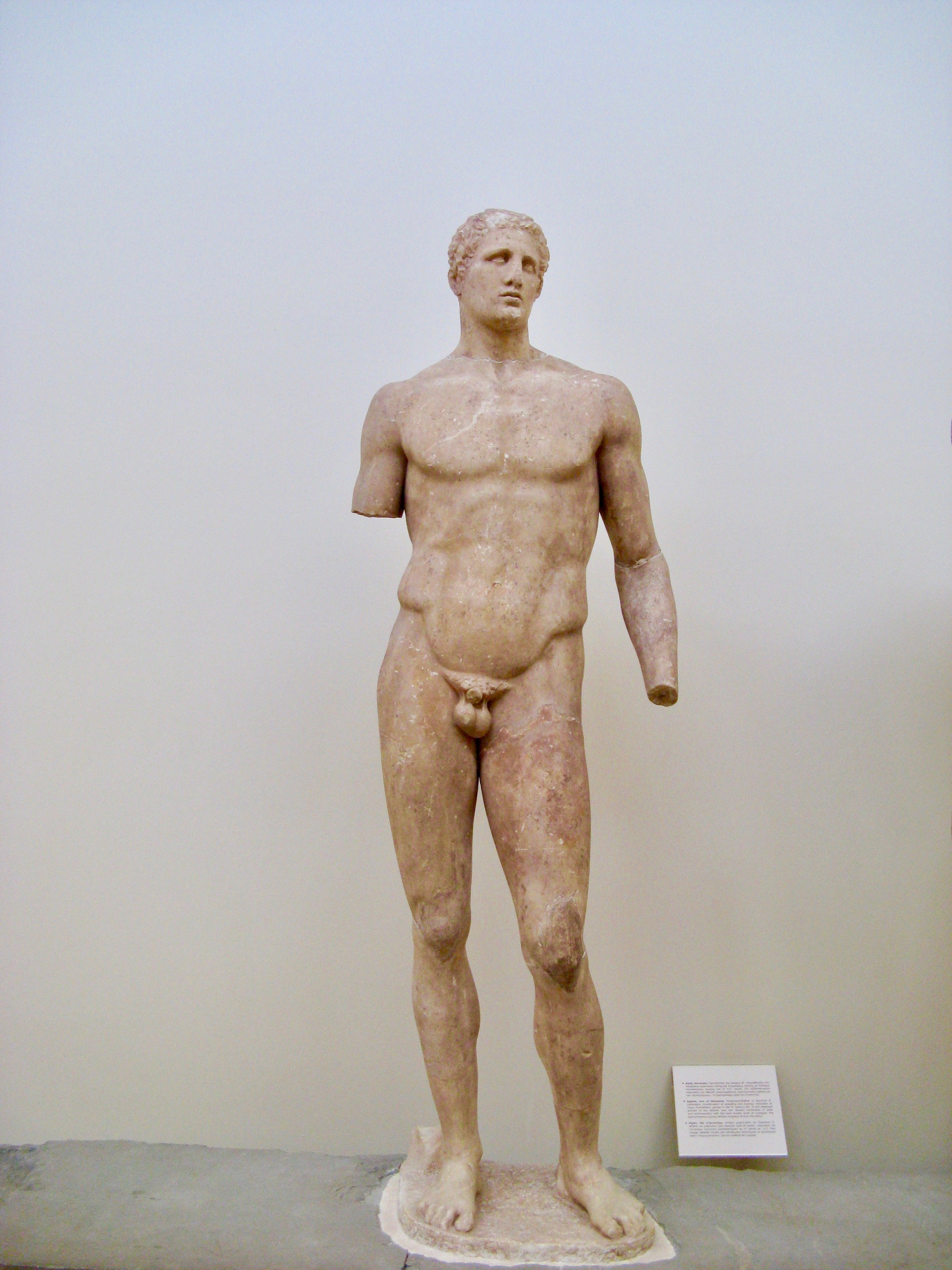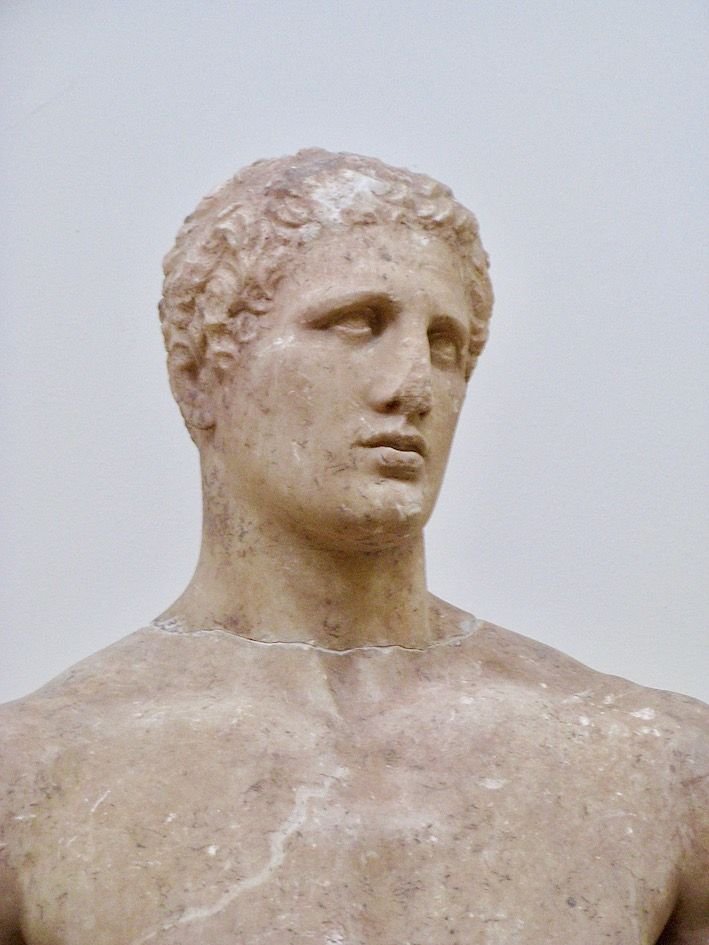
Lysippos is considered the last representative of the younger classical era, with the help of his groundbreaking works, he announced the arrival of a new age in the art of Hellenism (Makowiecka, 1987: 115).At the beginning of the Hellenistic era, Athens loses its leading role in art. The artists' emigration contributes to the strengthening of the sculptural workshop in other centers. Art has become more accessible and its market has expanded. Sculpture from the period around the year 300 BC, however, did not cut off the style from the one from 50 years ago. The main artistic centers were influenced by the heirs of the masters of the late classical period. Changes in the sculpture can be seen in Lysippos of Sicyon, whose style we can get to know thanks to the relations of Pliny (Natural History).
Lysippos has slithered his sculptures, thus obtaining the effect of increasing the perceived height of the character (Boardman, 1992: 162). The sculptures of Lysippos deviate from the current model of recreating reality in order to pick up the subjective perception of the phenomenon (Stewart, 1991: 186). Lysippus introduces a special type of symmetry based on a slender, sculpted body and small head (Estreicher, 1973: 133). In addition, he modeled the character's hair. This style proved to be crucial in the development of a new style of work: the artist's flexible approach to the individual needs of the client - the mimesis correlation of nature, with the current context. This flexibility will become the flagship feature of Hellenistic art, and the current classical traditions will be omitted.
Until 340, Lysippos bronze sculptures were coveted all over Greece and were replaced by those from the Polykleitos school. While none of these works survived, a copy of his performance of Hagias - a Thessalian warrior - was made in the 4th decade of the 4th century BC in Delphi. The dynastic group, to which Hagias belongs, made of parish marble and, to a large extent preserved until today, presents the Thessalian rulers with their ancestors. Hagias presents a completely new model of the head in Greek sculpture, far from a harmonized Polykleitos's standard. Characteristic here are strong cheekbones, narrow or small parts of the face, the vertical orientation of the posture. Tense muscles suggest energy slumbering in Hagias. The group to which Hagias belongs is oriented frontally, and the characters - staring into space, reducing the viewer to the role of a passive viewer.
Further changes in the sculpture can be seen in the sculpture of the athlete cleaning himself created by Lysippos - sculpting, scraping, sweat and dust from the body - Apoxyomenos. This copy is currently in the Museo Pio-Clementino in Rome, while the knowledge of the bronze original is derived from the accounts of Pliny the Elder.
Lysippos has developed a completely new canon of presenting a male figure, in which the proportion of the head to the whole body was 1/7. The sculptor broke with the classic rhythm and began to present his characters in motion. Apoxyomenos is the presentation of a young athlete who cleans the body after exercise, and whose hands both appear in action, the weight of the body rests on the left leg, but the other is also burdened. Gods and heroes are presented seated, resting after the hardships of accomplishments.
The athlete raises his right hand over the viewer's head. His face is idealized, he looks like a portrait and does not show shame, even though he is naked. The ideal of modesty goes into oblivion, replaced by the ethos to courage (Stewart, 1991: 187), to which Aristotle refers in Nicomachean Ethics (book IV).
A man is considered to be brave if he expects much and deserves much (...) He who does not demand much and deserves little is a sophron, but he is not brave - Aristotle, Nicomachean Ethics, book IV.3
Apoxyomenos gives the Greek sculpture a new ethos and activates the three-dimensional space around the work. In addition, the transfer of hands to the right side, the muscle system suggests the movement of the figure, and therefore three-dimensional space is not enough - the fourth time dimension is the one in which the movement takes place.
In portrait art from the second half of the 4th century BC, you can see the contrast of the athlete's ideal with philosopher's ideal, the strength of the body and spirit with the intellect. Assigned to Lysippos, the statuette from Alexandria presents Socrates standing, engaged in dialogue, with an idealized physiognomy. His view is directed at the world - it is an expression of a new ethos of magnanimity and courage.
Was Alexander an ideal example of the new ethos of the great spirit and valor? As noted by Stewart (1991: 188), this great individualist certainly influenced Lysippus imagination with his passion for "new and unexplored", unconventional in reasoning and feeling.
Lysippus huge success contributed to the fact that Philip II gave him the exclusive right to portray the ruler.
to be continued...
References
Images: sources linked below
Photo: @highonthehog
Makowiecka, E. Sztuka grecka – krótki zarys, Wydawnictwo Uniwersytetu Warszawskiego, Warszawa, 1987
Pliny,the Elder; Jex-Blake, K Urlichs, H Ludwig, The Natural History of Pliny; The elder Pliny's chapters on the history of art, London- New York, Macmillan and co., ltd. 1864
Boardman, J. (1993): The Diffusion of Classical Art in Antiquity, Princeton University Press, Princeton, NJ
Stewart, A. Greek Sculpture: An Exploration, Volume I: Text, Yale University Press, New Haven, 1991
Estreicher, K. (1973): Historia sztuki w zarysie, PWN, Krakow
Arystoteles, Etyka nikomachejska, tlum. Daniela Gromska, ks. IV.3 Wydawnictwo Naukowe PWN, Warszawa 2007








